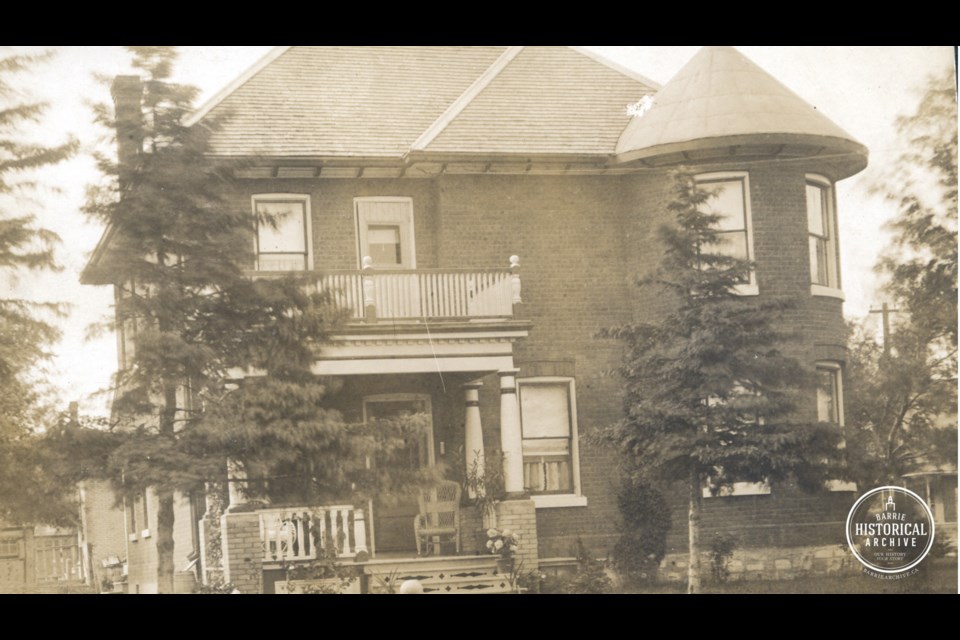This ongoing series from Barrie Historical Archive curator Deb Exel shows old photos from the collection and one from the present day, as well as the story behind them.
214 Dunlop St. W.
The lovely house at the corner of Dunlop and Frances streets was built about 1899-1900 for George R. Warnica and his wife, Mary.
Does the name Warnica sound familiar? It should.
Perhaps you’re familiar with Warnica Road in the Painswick area (once part of Innisfil Township, later annexed by the City of Barrie). While there is agreement the street was named for the Warnica family, there are two positions on who gets the credit.
Theory 1: Warnica Road was named for Burton Barnabus Warnica (1895-1985). B.B. Warnica, a successful farmer, first subdivided the area in 1953. Not confined to just farming and selling cattle to the U.S., Ireland and England, Warnica was active in the industry as president of the Ontario Cattlemen’s Association, a member of the Canadian Beef Advisory Board and Canadian Agricultural Hall of Fame. Locally, Warnica had served as president of the Barrie Fair and Agricultural Society and as chair of the Barrie Co-op. He also found time to be an elder at the Essa Road Presbyterian Church and serve as a trustee for S.S. (School Section) No. 13, otherwise known as the Painswick or Warnica School.
Then there’s the other theory.
The Warnica family is one of Innisfil’s earliest pioneer families, and Warnica Road was named for them broadly. George Frederick Hanning Warnica, born in Denmark in 1764, came to the U.S., marrying Catherine Wolfe in Salina, N.Y. They immigrated to Canada in 1815, first to Markham, and then to Innisfil, near Painswick, in 1825. The Warnicas had four sons: John, George Frederick, Joseph and William. The two elder brothers, John and George, were responsible for opening a road from Churchill to Tollendal. George and Phoebe’s home could be seen from Yonge Street (Highway 11), standing resolutely in a field.
The truly remarkable story of the Warnica family — specifically, George Frederick and his wife, Phoebe — is chronicled in extraordinary detail in a family memoir by one of their grandsons, Andrew Hunter, editor of the Barrie Examiner from 1889-95, historian, archeologist and author of the 1909 book A History of Simcoe County. Hunter’s boyhood home in the historic Queen’s Park neighbourhood still stands, and a plaque that commemorates Hunter is located outside the Carnegie building and former library on Collier Street.
But let’s return to George Frederick’s grandson, George Richard Warnica, who built the gracious West Village neighbourhood home on what was then Elizabeth Street.
The family lore, so the story goes, was “George was a free-living travelling man and George met his father, John, at the Chicago World’s Fair. John promised his son that if he settled down and came back to Innisfil, he would give George some good prime farmland.”
Bill Warnica, Innisfil resident and historian, dispelled the myth by pointing out the Chicago World’s Fair was in 1893. However, in 1875, George had already purchased his farm, Carpe Diem, on Highway 11, just west of the village of Stroud, from his grandfather “for a pretty penny and built a home, far from a gift.” George was already a husband (to Isabella Irving in 1881), father (he and Isabella had four children before she died in 1894) and successful farmer long before the World’s Fair in Chicago took place, proving family stories and legends can change in the telling and handing down over the years.
It’s no tale, however, George R. Warnica clearly did well at farming to be able to retire at an early age and build his fine home in Barrie, by then married to his second wife, Mary Burgess. Although his farming days were behind him, George was active about town, and was elected an alderman in 1908. He and Mary lived out their days at their beautiful home in town. Mary died in 1925 and George, in 1947.
George and Mary Warnica’s home has seen many modifications and additions since it was first built, but it’s still a West Village ‘looker’ and was a recipient of a Heritage Barrie Heritage Award in 2018.



